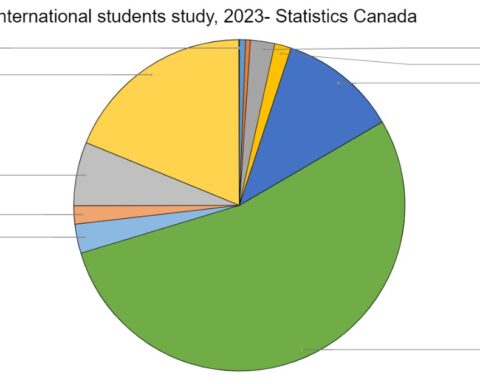Over half the population of international students in Ontario are deciding to stay put after graduating, and it’s for a good reason.
A recent study titled International Students in the Ontario Postsecondary System and Beyond, which was funded by Higher Education Quality Council of Ontario and presented at the National Metropolis Conference in Vancouver, shows a significant increase of international students living in the province between 2000 and 2012.
International Migration Research Centre (IMRC) researchers found an increase in students coming from Asia, Africa and the USA to study in Ontario, but more importantly found that over 50 per cent are opting to remain in Canada after completing their studies.
One of the IMRC researchers, Dr. Margaret Walton-Roberts, says it’s important to evaluate the students’ experiences, and how they are impacting Canadian immigration, when looking at the study’s findings.
“We need to understand what is happening to these students in terms of their transition into the labour market and transition into permanent residency,” says Walton-Roberts.
“Tuition fees are a transmission of funds to Canada’s post secondary sector. It is also an investment in an individual’s education. As long as that person can reap the benefits of their investments, that’s okay. Can they enter the labour market, or if they go back to their country, will their credentials offer them the opportunity to have a wage premium?” – Dr. Margaret Walton-Roberts, International Migration Research Centre
“International students are becoming more a part of the immigrant demand and that is a deliberate policy and pathway that the government has engaged in.”
An Economic Boost
According to the study, from 2002 to 2011, 190,000 international students came to Ontario and over 60,000 made a transition to another visa.
Walton-Roberts claims there are several factors to the growth, but most recognized is the Student Partners Program (SPP), which originated in 2009 as an assisting program for Indian students looking to study at Canadian college institutions. India is also the leading country in international student migration.
In addition to SPP boosting college registration, international students in general represent more of an economical boost in terms of immigration.
International students are now considered the fourth largest import in Canada and Walton-Roberts says the focus should be on making sure everyone benefits from this.
“We could look at it as a privatization of immigrant settlement processes,” she explains.
“I can’t shake the sense that we as international students are keeping the whole system afloat, but being chased away right after it’s done with us.” – Mahnoor Yawar, International Student
“Tuition fees are a transmission of funds to Canada’s post secondary sector. It is also an investment in an individual’s education. As long as that person can reap the benefits of their investments, that’s okay. Can they enter the labour market, or if they go back to their country, will their credentials offer them the opportunity to have a wage premium?”
Exorbitant Fees
For some international students, like 27-year-old Humber College journalism student, Mahnoor Yawar, from Dubai, it’s hard to see the benefits of the transmission of funds Walton-Roberts speaks of.
“I’m frankly tired of having to pay twice the tuition as local students and getting half the opportunities available to them,” Yawar says.
“I can’t shake the sense that we as international students are keeping the whole system afloat, but being chased away right after it’s done with us.”
For 22-year-old Achint Arora, who is studying accounting at George Brown College (GBC), his transition to Canada from India was relatively smooth, but costly.
“When we look at the major countries international students come from, you have to consider the gender politics in those countries and how comfortable families might be sending their daughters overseas.” – Dr. Margaret Walton-Roberts, International Migration Research Centre
He applied online, as well as successfully passing his International English Language Test with a score above average.
“I always wanted to study across seas, so I did my research, applied and they accepted me,” explains Arora.
When it comes to the fees, he agrees with Yawar. “For international students the fees are too high, and paying fees at universities are next to impossible. University is about $26,000 a year, and a college is $18,000. So I did some research, read reviews and decided to attend GBC.”
International students pay anywhere from $11,000 to $13,000 more than their domestic counterparts.
Gender Parity
Although many foreign students are entering into Ontario, there has been a significant decrease in female international students.
According to IMRC, from 2008 to 2012 there was a decrease of eight per cent of females coming to Ontario for education.
Walton-Roberts says it’s a reflection of the countries most international students migrate from.
“When we look at the major countries international students come from, you have to consider the gender politics in those countries and how comfortable families might be sending their daughters overseas.”
“If there is a person in India practicing accounting for 15 years, how can I compete with him? People who are applying outside of Canada, and [those] who are sitting in Canada, are now in the same boat, and it’s a competition.” – Achint Arora, International Student
Yawar says she was one of the fortunate females that was able to study abroad.
“There’s also a certain conservatism in the South Asian/Middle Eastern cultures that suggests women shouldn’t move out of their family homes, and especially so far away from it before they’re married,” says Yawar.
“I was lucky enough to have very supportive parents who want their girls to be able to support themselves before making major life decisions, so we ended up here.”
For some, Walton-Roberts says it boils down to money.
“It is a huge investment, and it may be that the family decides not to make that investment in their daughter.”
Life After Graduation
IMRC statistics show that 75 per cent of students transitioned from temporary to Permanent Residence (PR) in Ontario.
Plus, according to economic reports, they are making $3,000 more than the average permanent resident who did not study in Canada.
“We were only able to access certain data, and those transitioning, we did an estimate based on their characteristics and the pathways they took,” clarifies Walton-Roberts.
“[We’re] a headache for companies... I was told it will be a long process for both the company and international students to apply for PR, so it’s more convenient for them to hire a Canadian.” – Achint Arora, International Student
Despite the promising numbers, though, Arora says the hardest part of being an international student is actually obtaining a stable job after completing school. With only four years given to find and maintain a job after he graduates, the pressure is on, he adds.
“[Citizenship and Immigration Canada] is becoming tougher, especially with their new Express Entry,” explains Arora. “If there is a person in India practicing accounting for 15 years, how can I compete with him? People who are applying outside of Canada, and [those] who are sitting in Canada, are now in the same boat, and it’s a competition.”
Arora says another problem lies with companies not willing to go the extra mile to help recently graduated international students.
“[We’re] a headache for companies. They have to write a letter for my citizenship, a LMO, and more, just to apply for the Express Entry. I was told it will be a long process for both the company and international students to apply for PR, so it’s more convenient for them to hire a Canadian.”
But Roberts says that the colleges have effectively set up their programs for the labour market and in the next few years the process will be much more profitable.
“I suspect there is a focus on the college programs because there is in an interest in getting entry into the labour market,” she explains.
“The fees are already less and many colleges have oriented themselves to the international market. Recruiters are a part of that story as well and colleges have had a very active relationship with them through marketing their programs effectively overseas.”
For now, Yawar isn’t entering the labour market, but says when she does, getting a job in her field will be challenging for reasons centred on diversity, or a lack thereof.
“I know Toronto gets a lot of praise for being diverse and having the most opportunities for a career in media, but at the end of the day, it’s a claim based in statistics rather than action. The lack of diversity – in race, in gender, in class – in media careers is a genuine problem that few are ready to acknowledge, because the existing culture of privilege is too comfortable.”
Yawar continues, “Nevertheless, I have hope that there’s a position out there I’m uniquely suited for, and will keep seeking out every opportunity that comes my way.”





